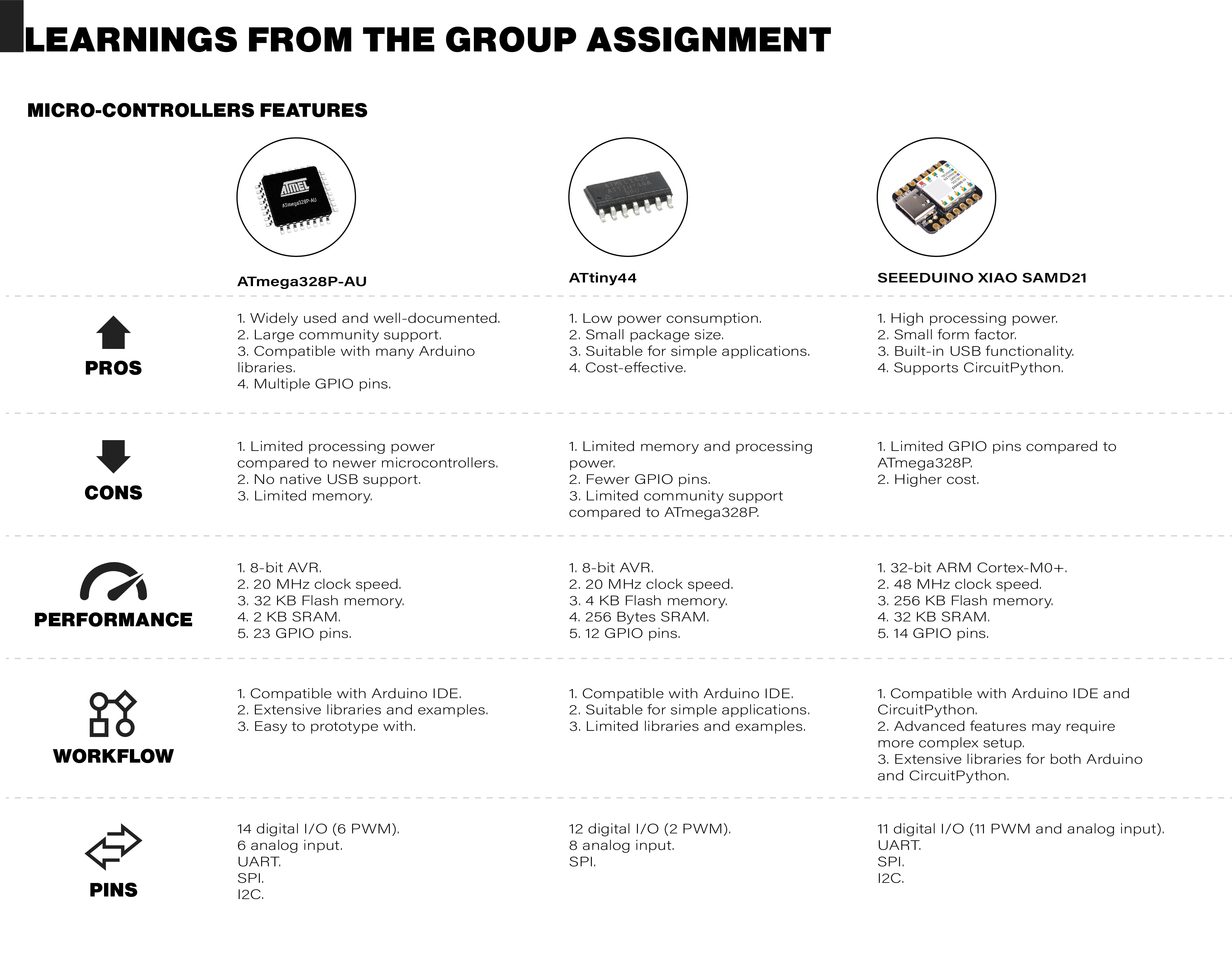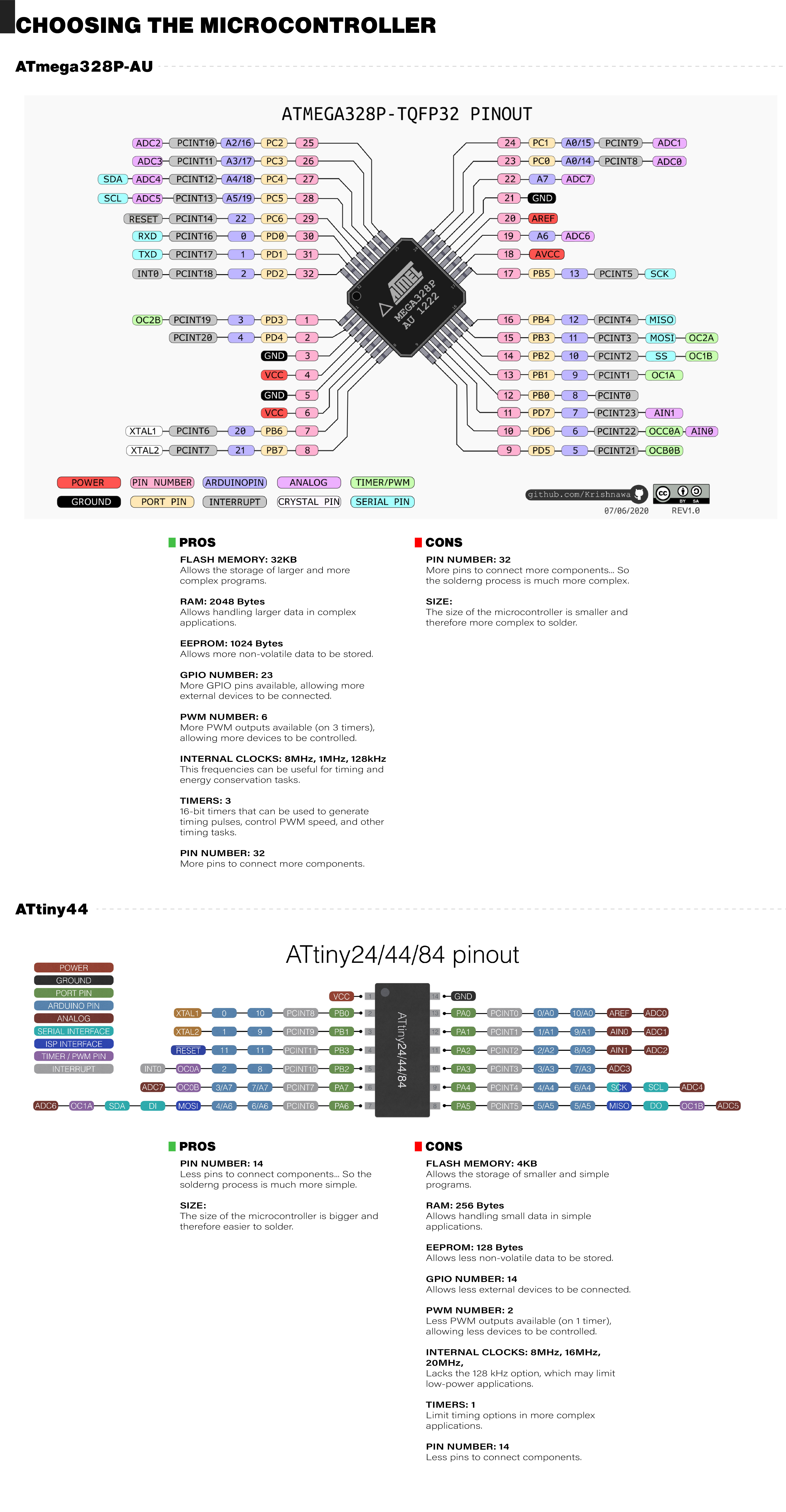Microcontroller's Comparison:
In this week's assigment we are comparing three popular microcontrollers: the ATtiny44, the ATmega328, and the Seeeduino XIAO based on the SAMD21. The ATtiny44 is a small, low-power microcontroller from the AVR family, known for its simplicity and efficiency in compact applications. The ATmega328, another member of the AVR family, is widely recognized for its versatility and extensive use in the Arduino Uno, making it suitable for a broad spectrum of projects. The Seeeduino XIAO, based on the ARM Cortex-M0+ architecture, stands out for its high performance in a tiny form factor, ideal for modern, high-demand applications such as wearables and IoT devices. This comparison will explore their technical specifications, features, development tools, and typical use cases to provide a comprehensive understanding of their strengths and weaknesses.

Atmega328p and Attiny44:

Technical Specifications
| Feature |
ATtiny44 |
ATmega328 |
Seeeduino XIAO (SAMD21) |
| Core Architecture |
AVR |
AVR |
ARM Cortex-M0+ |
| Clock Speed |
Up to 20 MHz |
16 MHz |
48 MHz |
| Flash Memory |
4 KB |
32 KB |
256 KB |
| SRAM |
256 bytes |
2 KB |
32 KB |
| EEPROM |
256 bytes |
1 KB |
None (emulated in flash) |
| Power Consumption |
Low |
Moderate |
Low |
| Operating Voltage |
1.8V - 5.5V |
1.8V - 5.5V |
3.3V |
| Package Type |
SOIC, QFN, PDIP |
TQFP, PDIP, QFN |
SMD |
| Pin Count |
14 |
28 |
14 |
Features and Peripherals
| Feature |
ATtiny44 |
ATmega328 |
Seeeduino XIAO (SAMD21) |
| I/O Pins |
12 |
23 |
11 |
| ADC |
10-bit, 8 channels |
10-bit, 6 channels |
12-bit, 11 channels |
| UART |
1 |
1 |
1 |
| I2C |
1 |
1 |
1 |
| SPI |
1 |
1 |
1 |
| Timers and Counters |
2 (8-bit, 16-bit) |
3 (2x 8-bit, 1x 16-bit) |
4 (4x 16-bit) |
| PWM Channels |
4 |
6 |
11 |
Development Tools and Ecosystem
| Feature |
ATtiny44 |
ATmega328 |
Seeeduino XIAO (SAMD21) |
| Development Boards |
Custom, Digispark |
Arduino Uno, Nano |
Seeeduino XIAO |
| IDEs |
Arduino IDE, AVR Studio |
Arduino IDE, AVR Studio |
Arduino IDE, PlatformIO |
| Libraries |
Limited AVR libraries |
Extensive Arduino libraries |
Extensive Arduino libraries |
| Community Support |
Moderate |
Very High |
Growing |
Applications and Use Cases
ATtiny44:
- Small projects
- Battery-powered devices
- Simple I/O control
ATmega328:
- General-purpose projects
- Prototyping (Arduino Uno)
- Embedded systems
Seeeduino XIAO (SAMD21):
- Compact and high-performance applications
- Wearables
- IoT devices
Conclusion
Summary:
- ATtiny44 is great for compact, low-power applications with basic requirements.
- ATmega328 is versatile and well-supported, making it suitable for a wide range of projects.
- Seeeduino XIAO (SAMD21) offers high performance in a small form factor, ideal for modern applications requiring more processing power and memory.
Recommendations:
- Choose ATtiny44 for simple, low-power tasks.
- Use ATmega328 for general-purpose applications and prototyping.
- Opt for Seeeduino XIAO (SAMD21) for high-performance, space-constrained projects.


